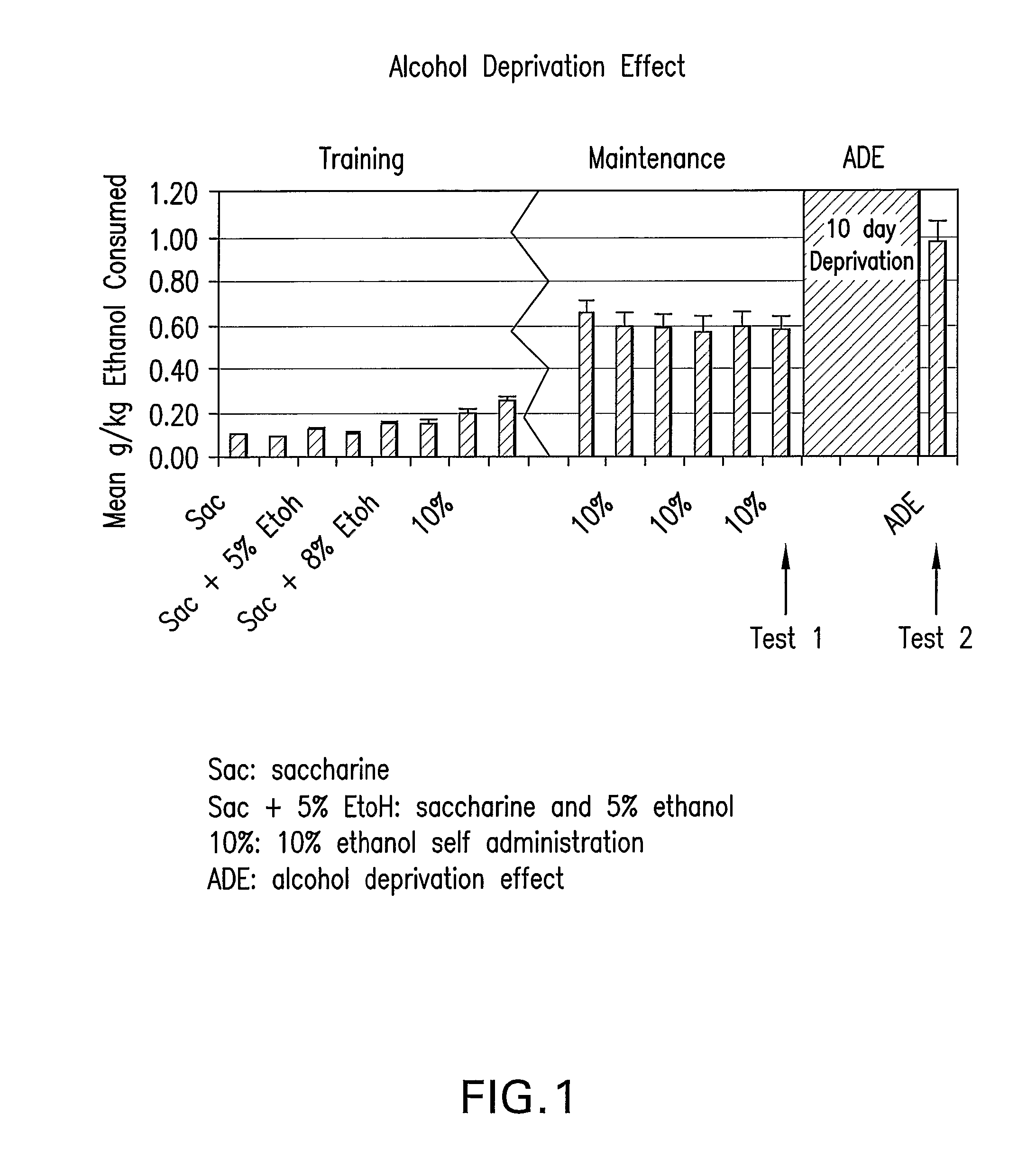Inhibition Of Voluntary Ethanol Consumption With Non-Peptidyl Melanocortin-4 Receptor Agonists
a technology of peptide melanocortin and ethanol consumption, which is applied in the direction of heterocyclic compound active ingredients, biocide, drug compositions, etc., can solve the problems of impaired control of drinking, alcohol abuse is one of the most significant problems, and the economic cost of alcohol abuse to the united states is estimated to be nearly $150 billion per year, etc., to achieve the effect of reducing alcohol consumption and preventing alcohol consumption
- Summary
- Abstract
- Description
- Claims
- Application Information
AI Technical Summary
Benefits of technology
Problems solved by technology
Method used
Image
Examples
example 1
Binding Assay
[0128] The membrane binding assay was used to identify competitive inhibitors of 125I-NDP-alpha-MSH binding to cloned human MCRs expressed in mouse L- or Chinese hamster ovary (CHO)-cells.
[0129] Cell lines expressing melanocortin receptors were grown in T-180 flasks containing selective medium of the composition: 1 L Dulbecco's modified Eagles Medium (DMEM) with 4.5 g L-glucose, 25 mM Hepes, without sodium pyruvate, (Gibco / BR1); 100 ml 10% heat-inactivated fetal bovine serum (Sigma); 10 mL 10,000 unit / mL penicillin & 10,000 μg / mL streptomycin (Gibco / BR1); 10 ml 200 mM L-glutamine (Gibco / BR1); 1 mg / mL geneticin (G418) (Gibco / BR1). The cells were grown at 37° C. with CO2 and humidity control until the desired cell density and cell number was obtained.
[0130] The medium was poured off and 10 mls / T-180 flask of enzyme-free dissociation media (Specialty Media Inc.) was added. The cells were incubated at 37° C. for 10 min or until cells sloughed off when flask was banged ag...
example 2
cAMP Functional Assay
To Discriminate Melanocortin Receptor Agonists from Antagonists
[0137] Cells (for example, CHO- or L-cells or other eukaryotic cells) expressing a human melanocortin receptor (see e.g. Yang-YK; Ollmann-MM; Wilson-BD; Dickinson-C; Yamada-T; Barsh-GS; Gantz-I; Mol-Endocrinol. 1997 March; 11(3): 274-80) were dissociated from tissue culture flasks by rinsing with Ca and Mg free phosphate buffered saline (14190-136, Life Technologies, Gaithersburg, Md.) and detached following 5 min incubation at 37° C. with enzyme free dissociation buffer (S-014-B, Specialty Media, Lavellette, N.J.). Cells were collected by centrifugation and resuspended in Earle's Balanced Salt Solution (14015-069, Life Technologies, Gaithersburg, Md.) with additions of 10 mM HEPES pH 7.5, 5 mM MgCl2, 1 mM glutamine and 1 mg / ml bovine serum albumin. Cells were counted and diluted to 1 to 5×106 / mL. The phosphodiesterase inhibitor 3-isobutyl-1-methylxanthine was added to cells to 0.6 mM.
[0138] Agoni...
example 3
Maintenance Ethanol Self-Administration Following Treatment of MC4R Agonist (Compound A)
[0143] Animals: Male Wistar rats were used in all experiments. Body weight was 180-200 g at the start of the experiments. Rats were housed 2-3 per cage with food and water available ad libitum. Lights were on a 12-hour light / dark cycle, with lights on at 0600. All procedures met the guidelines of the National Institutes of Health Guide for the Care and Use of Laboratory Animals.
[0144] Operant Ethanol Self-Administration: Ethanol dilutions (5, 8 and 10% w / v) were prepared with 95% ethyl alcohol and tap water. Saccharin (Sigma Chemical Co., St. Louis, Mo.) was added to water or ethanol solutions to achieve a concentration of 0.2% w / v. Standard operant chambers (Med Associates, VT) housed in sound-attenuated chambers were used for ethanol self-administration. Syringe pumps dispensed ethanol and water into two stainless steel reservoirs mounted 4 cm above the floor of the chamber, centered between ...
PUM
| Property | Measurement | Unit |
|---|---|---|
| Mass | aaaaa | aaaaa |
| Mass | aaaaa | aaaaa |
| Molar density | aaaaa | aaaaa |
Abstract
Description
Claims
Application Information
 Login to View More
Login to View More - R&D
- Intellectual Property
- Life Sciences
- Materials
- Tech Scout
- Unparalleled Data Quality
- Higher Quality Content
- 60% Fewer Hallucinations
Browse by: Latest US Patents, China's latest patents, Technical Efficacy Thesaurus, Application Domain, Technology Topic, Popular Technical Reports.
© 2025 PatSnap. All rights reserved.Legal|Privacy policy|Modern Slavery Act Transparency Statement|Sitemap|About US| Contact US: help@patsnap.com



